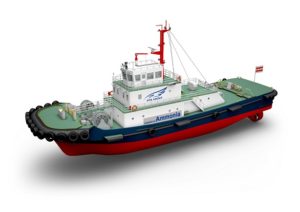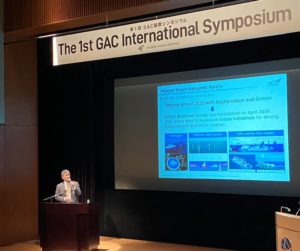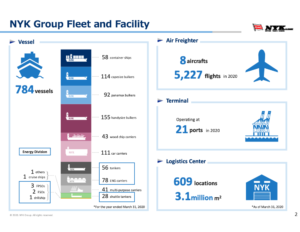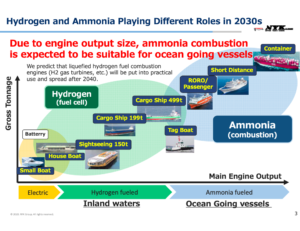Japan’s NYK and partners to develop ammonia fueled and fueling vessels
By Trevor Brown on September 17, 2020

In recent weeks, the Japanese shipping company NYK Line has announced a series of high-profile research and development collaborations that aim to establish ammonia fueled vessels and fuel supply. Its partners in these projects include classification society Class NK, engine manufacturer IHI Power Systems, and shipbuilder Japan Marine United Corporation.
Three vessel types have been announced, so far, including an ammonia-fueled ammonia gas carrier, an ammonia barge for offshore bunkering, and an ammonia-fueled tugboat (for navigating the barge). Pushing beyond the initial research phase, these collaborations aim for commercialization and to put these vessels “into practical use.”
This joint R&D aims not only to utilize ammonia as a marine fuel but also to establish methods for the mass transportation and supply of ammonia …
As a result, the R&D is expected to contribute significantly to the decarbonization of not only the maritime industry but also the energy industry.
NYK Line announcement, Joint R&D Starts for Use of Ammonia in Marine Transportation to Reduce GHG Emissions, August 12, 2020
Mass transportation and supply
NYK’s Green Business Group was established in April 2019, the same month that the Green Ammonia Consortium (GAC) launched in Japan. NYK is one of GAC’s general members; other GAC members include NYK’s partners Class NK, IHI Corporation, and JFE Engineering (Japan Marine United Corporation is a joint venture between the shipbuilding arms of these last two organizations).

At the GAC’s 1st International Symposium, in January 2020, NYK disclosed initial details of “its approach of using ammonia as marine fuel for zero-emission ships.”
Six months later, in June 2020, NYK was announced as a founding partner of another major maritime industry consortium, the Mærsk Mc-Kinney Møller Center for Zero Carbon Shipping, alongside ABS, A.P. Moller – Maersk, Cargill, MAN Energy Solutions, Mitsubishi Heavy Industries, and Siemens Energy. This research institute, headquartered in Copenhagen, was established “to develop new fuel types and technologies” that would enable the shipping sector to reduce its emissions in line with the IMO’s GHG Strategy.

Over the last few years, almost every maritime ammonia announcement has focused on the use of ammonia as a fuel. However, it is important to remember that, at least in Japan today, demand for low-carbon ammonia is being driven by the power sector, not the maritime sector. Ammonia co-combustion in coal-fired power plants is likely to become a large-scale pathway to partially decarbonize the Japanese electric grid this decade. To do this, Japan will need to import a tremendous amount of ammonia — and NYK Line, with its current fleet of 56 tankers and 78 LNG carriers, is preparing to meet this demand.
NYK is participating in the [Green Ammonia] Consortium to consider not only the maritime transport of ammonia as a power generation fuel used by electric power companies but also the use of ammonia as marine fuel, one of the solutions for decarbonization.
NYK Group announcement, NYK Examines Concept of Using Ammonia as Marine Fuel, January 30, 2020
The synergy here is clear: as NYK’s gas carrier and tanker business transitions from fossils to the fuels of the future, it will be in an advantaged position to demonstrate and adopt those fuels itself.
Ammonia-fueled Ammonia Gas Carrier

NYK’s ammonia-fueled ammonia gas carrier (AFAGC) will use ammonia as its main fuel — likely in a dual-fuel configuration due to ammonia’s combustion properties. The fact that this vessel’s main fuel is also its cargo means that, relative to other types of ship, a gas carrier has the potential to reduce the cost and complexity of the design, engineering, construction, and operation of an ammonia fueled vessel. For this reason, NYK expects this class of vessel “will contribute to the early realization of zero emissions for oceangoing vessels.”
It may be noteworthy that the responsibilities of Class NK on this specific project are more than is necessary for a classification society engaged in research and development. Beyond its core role providing “technical verification regarding safety,” Class NK is also undertaking “development of guideline,” implying a fast-track to drafting formal regulations regarding ammonia as a maritime fuel at the IMO level.
Ammonia Floating Storage and Regasification Barge

The barge represents an essential element of the maritime industry’s transition to ammonia: how to put the necessary volume of fuel in the correct location. The sector must manage tremendous uncertainties while making very high capital expenditures, and the use of floating bunkering assets, as opposed to land-based operations, represents a viable, low-regret solution, enabling the sector to take swift, confident action.
As demand for ammonia fuel is foreseen to expand, the need for a transportation infrastructure for stable supply is expected to increase …
In this joint R&D project, we will be engaged in the R&D of a barge that is equipped with a floating storage and regasification facility exclusively for ammonia for the first time in the world. This project is expected to contribute to the early introduction of ammonia fuel by utilizing the barge as an alternative to land facilities (storage tanks, regasification facilities, etc.) for the stable supply of ammonia fuel.
NYK Line announcement, Joint R&D Starts for Use of Ammonia in Marine Transportation to Reduce GHG Emissions, August 12, 2020
NYK Line is not alone in its intention to develop offshore bunkering infrastructure for ammonia. In June 2020, Itochu Corporation announced that it would be developing “off-shore facility such as floating tank and/or fuel supply ship” for ammonia vessel refueling in the Port of Singapore. Itochu, another Japanese shipping firm, is joined in that project by Dutch storage tank and fuel terminal operator Vopak, which is studying the feasibility of land-based ammonia bunkering infrastructure.
Ammonia-fueled Tugboat
Of course, these barges have no engines: they merely float, and must be pushed and pulled into position by a tugboat.
In fiscal 2020 we will tackle themes such as technological development of the hull, engine, and fuel supply system, and development of safety navigation methods. After evaluating the practicality of the R&D results, we will begin study of the construction of the ammonia-fueled tugboat and the plan for construction.
NYK Line announcement, Joint R&D Starts for Practical Application of Ammonia-fueled Tugboat, September 3, 2020
The three partners on this tugboat project, NYK, IHI, and Class NK, all previously collaborated on another tugboat, the Sakigake, built in 2015, when it was “Japan’s first ship fueled by liquefied natural gas (LNG).”
Ammonia in the fuel portfolio
This week, the University of California, Irvine hosted the 2020 edition of its annual ICEPAG colloquium, examining hydrogen as a “Platform for Sustainability.”
As part of a session focused on decarbonizing freight, NYK’s Kazumasa Taruishi gave a presentation entitled Hydrogen Solutions for Ocean-Going Vessels.
Proponents of ammonia fuel talk a lot about energy density. This is the reason that ammonia may be, for some applications, a “better” fuel choice than batteries or hydrogen. However, a key insight from this presentation related not to energy density but to power density.

Direct electrification will always be the most energy efficient solution, of course, but batteries are not fit for purpose as the main power source on a big ship — they lack energy density.
Hydrogen is an excellent alternative but, today, the fuel cells that convert hydrogen energy into motive power lack the necessary power density. Maritime fuel cells are currently available in the range of only a few hundreds of KWs, but, to an extent, this can be improved. This month, it was announced that NYK is actively engaged in “a demonstration project for the commercialization of high-power Fuel Cell (FC) vessels,” with Toshiba Energy, Kawasaki Heavy Industries, ENEOS, and ClassNK.
The Companies will develop an about 150 ton class (i.e. passenger capacity: approx. 100) high-power FC vessel that will function as a medium-sized tourist ship … Construction and production is expected to start in 2023, and pilot operation of the vessel along the coast of Yokohama port is scheduled to begin in 2024.
Toshiba Energy Systems announcement, Demonstration Project Begins for Commercialization of Vessels Equipped with High-power Fuel Cells, September 1, 2020
Announced earlier this year, the Viking Energy demonstration also aims to demonstrate a high-power fuel cell engine, a 2 MW solid oxide system that uses ammonia as a direct fuel. But today’s large, powerful ocean-going freight vessels have internal combustion engines with power ratings up to 70,000 KWs — orders of magnitude more than fuel cells will be able to deliver in the foreseeable future.
For this reason, NYK and others in the maritime sector are becoming increasingly focused on ammonia not just because of its greater energy density, but also because of its power density: its compatibility with the massive internal combustion engines that the maritime industry uses to move the world’s freight.